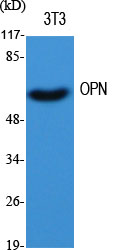
| WB | 咨询技术 | Human,Mouse,Rat |
| IF | 咨询技术 | Human,Mouse,Rat |
| IHC | 1/50-1/100 | Human,Mouse,Rat |
| ICC | 技术咨询 | Human,Mouse,Rat |
| FCM | 咨询技术 | Human,Mouse,Rat |
| Elisa | 1/10000 | Human,Mouse,Rat |
| Aliases | SPP1; BNSP; OPN; PSEC0156; Osteopontin; Bone sialoprotein 1; Nephropontin; Secreted phosphoprotein 1; SPP-1; Urinary stone protein; Uropontin |
| Entrez GeneID | 6696 |
| WB Predicted band size | Calculated MW: 35 kDa; Observed MW: 60 kDa |
| Host/Isotype | Rabbit IgG |
| Antibody Type | Primary antibody |
| Storage | Store at 4°C short term. Aliquot and store at -20°C long term. Avoid freeze/thaw cycles. |
| Species Reactivity | Human,Mouse,Rat |
| Immunogen | The antiserum was produced against synthesized peptide derived from human Osteopontin. AA range:261-310 |
| Formulation | Purified antibody in PBS with 0.05% sodium azide,0.5%BSA and 50% glycerol. |
+ +
以下是关于Osteopontin抗体的3篇参考文献的简要概括:
---
1. **文献名称**: *"Osteopontin as a multifaceted driver of bone metastasis and drug resistance"*
**作者**: Wei R, et al.
**摘要**: 探讨了Osteopontin(OPN)在肿瘤骨转移和化疗耐药中的作用,研究利用特异性抗体阻断OPN信号通路,显著抑制了癌细胞侵袭并增强化疗敏感性。
2. **文献名称**: *"Development of a high-affinity anti-Osteopontin antibody for immunohistochemical analysis of human cancers"*
**作者**: Sato T, et al.
**摘要**: 报道了一种新型高特异性OPN抗体的开发,验证其在多种癌症组织(如乳腺癌、肝癌)中的免疫组化应用,证实OPN表达与患者预后不良相关。
3. **文献名称**: *"Targeting Osteopontin in inflammatory diseases: antibody-based therapeutic strategies"*
**作者**: Wang KX, et al.
**摘要**: 综述了OPN在类风湿性关节炎、多发性硬化等炎症疾病中的调控机制,并评估了单克隆抗体通过中和OPN蛋白减轻炎症反应的临床前研究进展。
---
这些文献覆盖了OPN抗体在癌症诊断、治疗及炎症疾病中的关键应用,反映其研究多样性。如需具体期刊或年份信息,可进一步补充说明。
Osteopontin (OPN), also known as secreted phosphoprotein 1 (SPP1), is a multifunctional glycoprotein involved in diverse physiological and pathological processes, including immune regulation, inflammation, tissue remodeling, and cancer progression. It binds to cell surface receptors like integrins and CD44. modulating cell adhesion, migration, and signaling. OPN exists in multiple isoforms due to alternative splicing and post-translational modifications, contributing to its functional versatility. Its overexpression has been linked to diseases such as cancer metastasis, atherosclerosis, and chronic inflammatory conditions, making it a biomarker and therapeutic target.
Antibodies against osteopontin are critical tools for studying its expression, localization, and function. They are widely used in techniques like Western blotting, immunohistochemistry (IHC), immunofluorescence (IF), and enzyme-linked immunosorbent assays (ELISA) to quantify OPN levels in tissues, serum, or cell cultures. Monoclonal antibodies offer high specificity for particular epitopes, while polyclonal antibodies may detect multiple isoforms. Some antibodies distinguish between full-length OPN and its thrombin-cleaved fragments, which have distinct biological activities.
In research, OPN antibodies help elucidate its role in tumor microenvironment modulation, bone metabolism, and immune evasion. Clinically, they aid in diagnosing or prognosticating diseases like breast cancer, osteoporosis, and renal fibrosis. Challenges include cross-reactivity with other proteins or isoforms, emphasizing the need for rigorous validation. Recent advances focus on developing therapeutic antibodies to block OPN-receptor interactions in cancer or autoimmune diseases, highlighting its translational potential.
×